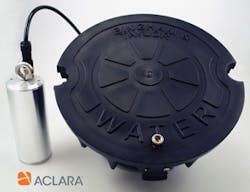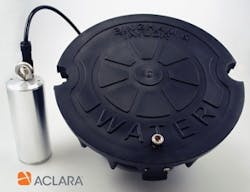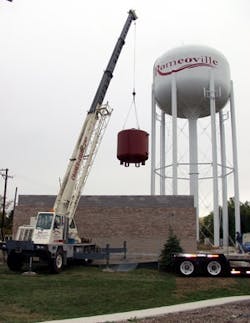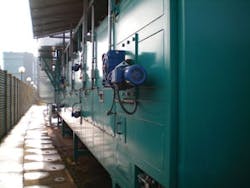Radium Compliance Achieved with Ion Exchange Technology
By Joseph Sanchez
Several Ion Exchange Plants have been commissioned in Romeoville, IL, to improve its water quality by reducing existing levels of radium in the drinking water below requirements mandated by the Environmental Protection Agency.
Located 30 minutes southwest of Chicago, the Village of Romeoville draws its water from a ground water supply consisting of five deep wells with pump settings of approximately 1,500 ft. below the surface and seven shallow wells pumping 150-300 ft. below the surface. The village pumps over 3.8 million gallons a day to over 50,000 residents in the suburb and nearby service areas, which totals over 1.4 billion gallons a year.
An aerial view of Romeoville's first Ion Exchange Softening Plant located alongside one of the village's newest water pumping stations.
In compliance with EPA regulations, the village conducts quarterly water sample testing. The quarterly tests had revealed slightly elevated levels of radium (226 and 228) in the aquifer from which the village draws most of its water supply. The radium levels exceeded the Illinois Environmental Protection Agency's maximum level of 5 picocuries per liter or pCi/L.
Radium occurs naturally in trace amounts in rocks, soils, and many ground water aquifers. This radiation source is a component of the background radiation to which all living creatures are exposed. As radium naturally breaks down, sometimes it enters our water supplies.
The radium level average in 2004, according to Romeoville's water quality report that year, ranged from 1.8 pCi/L – 7.2 pCi/L. This is an issue the Village of Romeoville took seriously and was determined to resolve.
An extensive water supply and treatment investigation was conducted to analyze the various radium removal treatment processes available such as iron/manganese co-filtration with hydrous manganese oxide addition, radium selective media, reverse osmosis and ion exchange softening. The village engineer and Romeoville chose ion exchange softening as the treatment solution.
Ion Exchange Softening
Ion exchange softening, I/X, is a common approach to removing a variety of dissolved solids in water. It exchanges both cations (positively charged particles) and anions (negatively charged particles) depending on the application.
One of Romeoville's completed Ion Exchange Softening/Treatment systems responsible for removing unwanted nitrates, sulfates and reducing radium levels while achieving a higher level of softness.
For hardness and radium removal, a cationic exchange process is used. This process involves a pressurized vessel filled with synthetic resin material, coated with an ion exchange material. The material is heavily loaded with sodium ions, but because the media has a higher affinity for other cations, the sodium is exchanged with calcium, magnesium, or radium ions as they come in contact with the media.
As the process continues, all available sodium ions are exchanged and the media will require regeneration. To accomplish this, a sodium chloride solution saturates the media. The saturation overrides the media's affinity for the other cations and re-coats the surface with sodium ions for the next treatment cycle.
The regeneration process results in 3 to 5 percent waste, which is favorable when compared to reverse osmosis treatment, and just slightly higher than co-precipitation. Removal of hardness and radium is 98% to 100%. However, treating all of the water supply with ion exchange softening can lead to aggressive water. To polish the water, experts recommend that operators bypass and blend a percentage of the water. In Romeoville, bypassing occurs in differing amounts depending on the radium, hardness levels in the raw water and the desired removal amount.
Although the waste produced from the I/X contains radium removed during the treatment process, it is not currently regulated. Besides radium selective absorbent medias, which capture the radium for future hauling and disposal in licensed hazardous waste landfills, all other conditional radium treatment methods will contain radium laden waste. This radium-laden waste typically routes to the wastewater treatment plant through the sanitary sewer collection system where a portion settles into the sludge waste and a portion remains in the plant effluent.
The I/X treatment process produces a high-quality water. The removal of hardness reduces scale and lime build-up on fixtures and increases the life of water heaters and dishwashers. It has slightly higher operation and maintenance costs due to the use of a brine solution for the regeneration process but municipalities would probably agree that the benefits of soft water, free of contaminants outweighs the slightly higher costs associated with the treatment process.
Installation, Integration
The village and its engineering consultant worked closely with Illinois-based Metropolitan Industries to supply and integrate all necessary equipment required for operation. At each site, the company provided three new ion exchange treatment vessels, over 20 control valves, a computer controlled backwash and regeneration system with color touch screen operator interface and programmable logic controller (PLC). The project team incorporated the entire system into an addition at the existing well house/reservoir and booster pumping station.
The new I/X system was then integrated into the village's recently upgraded Wireless SCADA system, responsible for the monitoring and control of water and wastewater pump and control infrastructure within the village. This integration allows water operators to precisely control and monitor the new I/X system from distant locations via secure cellular communications and Internet technology.
Conclusion
The Illinois Environmental Protection Agency mandates that all water providers in the state comply with its maximum contaminant level of 5.0 pCi/L. Although this can be a significant investment for most municipalities, there is the added benefit for users of I/X because the process softens hard water proportionally with the reduction of radium. This leaves water customers pleased about the quality of their water and relieves them from purchasing and maintaining softening treatment systems for their homes.
Romeoville is not the only community in the area battling radium regulation. In the late 1990s Illinois EPA made final rulings after long debate and began enforcement of radium regulations. Many surrounding communities are struggling with affordable approaches to comply with these regulations. Romeoville was one community to take advantage of technology to enhance their water operations. WW
About the Author:Joseph Sanchez is the director of public relations for Metropolitan Industries and is responsible for educating and informing members of the water and wastewater industry about advances in pumping technology. He can be contacted at [email protected].
More WaterWorld Current Issue Articles
More WaterWorld Archives Issue Articles



